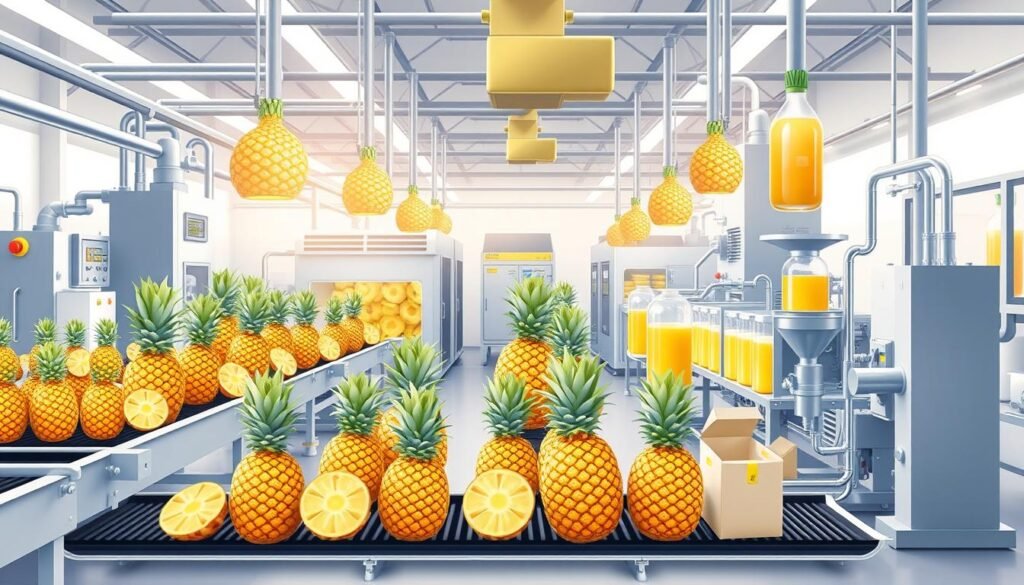Did you know only 30% of pineapples in China are processed? This leaves a huge opportunity in pineapple processing. As demand for top-notch pineapple products grows, it’s key to grasp the details of processing methods and technologies. We’re about to dive into the world of pineapple processing, showing how better techniques can boost product quality and meet market needs.
The pineapple industry in China is seeing big leaps forward. With over 1.5 million tons produced each year, there’s a lot of room for improvement in peeling and processing. Places like Guangdong and Hainan are at the forefront, but new equipment and methods can change the game. Let’s explore the exciting world of pineapple processing, where we can increase yields and support sustainable and innovative products.
Key Takeaways
- Pineapple processing is only tapping into 30% of its potential in major production regions like China.
- Guangdong and Hainan are pivotal in pineapple production, contributing significantly to overall yields.
- Innovative machines like the Bway Pineapple Peeling and Coring Cutting Combo Machine enhance efficiency and reduce labour costs.
- New processing technologies are being developed to improve product quality and extend shelf life.
- By-products from pineapple processing can be leveraged for sustainable practices in various industries.
- Understanding advanced methodologies can lead to higher yield recovery in pineapple processing.
- The introduction of UHT processing is a game-changer for extending the longevity of pineapple products.
The Essential Role of Pineapple Processing in Today’s Market
The pineapple processing industry is a key part of the global economy. It’s driven by a market demand for pineapple products worth over $8 billion. This industry not only meets consumer needs but also boosts economic growth.
In South Africa, 80% of pineapple production goes to processing. This shows how much of the fruit’s potential is used through new methods. The other 20% is sold fresh, highlighting both the challenges and opportunities in this area.
Every year, the world produces around 24.8 million tons of pineapples. This industry relies on being efficient and sustainable. In Thailand, for example, they turn waste into valuable resources. They manage to use about 200 tons of waste daily, showing the importance of good waste management.
The drive to improve pineapple processing is clear. New methods are being developed to increase productivity and reduce waste. This helps meet the growing demand for pineapple products and ensures they are supplied efficiently.
A Brief History of Pineapple: From Wild Fruit to Industrial Staple
The pineapple’s story is long and fascinating, spanning over six millennia. It all started in South America, where people first grew pineapples around 1200-800 BC in Peru and 200 BC – 700 AD in Mexico. These early efforts set the stage for the pineapple’s global importance.
Christopher Columbus introduced pineapples to Europe in 1493, after finding them in Guadeloupe. The 17th century saw pineapples become a symbol of luxury in Europe. They captured the hearts of the wealthy.
By the 1820s, pineapples were being grown commercially, mainly in greenhouses and tropical areas. Pineapples grow in about a year, producing around 200 flowers for each fruit. After the first fruit, the plant grows new shoots called ‘suckers’. Cultivated pineapples are often hand-pollinated, while wild ones rely on hummingbirds.
As time went on, new ways to grow and process pineapples emerged. Pineapple plants use a special way to make food at night, called CAM photosynthesis. This helps them thrive in many tropical places.
Today, pineapples are grown in many tropical areas, with Brazil leading in production. They are used in many ways, from canned slices to juice. This shows how pineapples have become key in both food and industry. Our look into the pineapple’s history shows how it’s linked to domestication and industrial production.

Understanding Pineapple Varieties and Their Unique Characteristics
Pineapples are part of the tropical fruits family. They come in many pineapple varieties with special traits for different uses. We group them into five main types: Cayenne, Spanish, Queen, Pernambuco, and Mordilona. Each type has its own unique flavors and qualities.
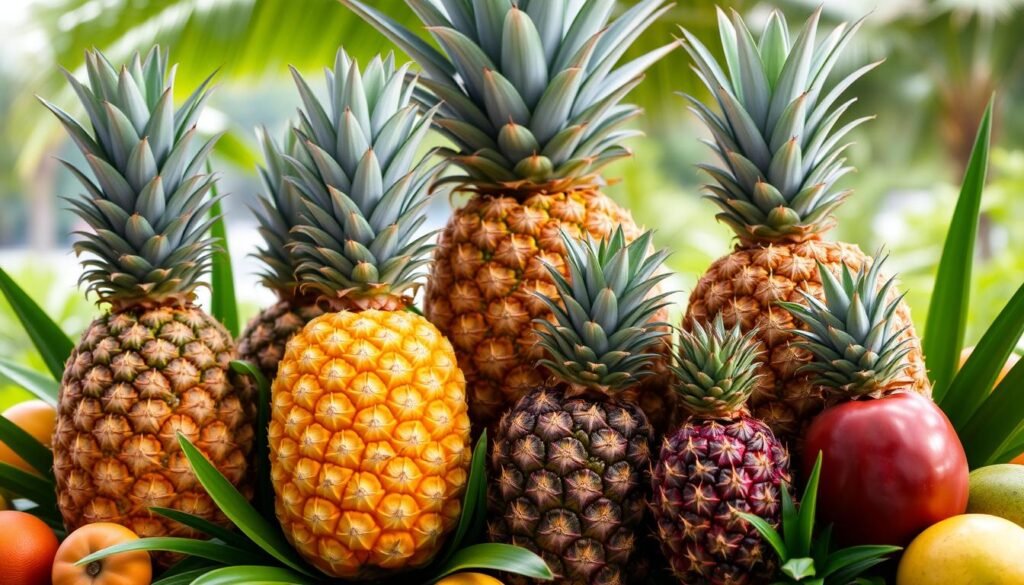
The Smooth Cayenne is known for its juicy taste and sweetness. The Red Spanish has a tangy taste. The Queen variety is small but has a lovely aroma. These varieties help make a wide range of products, like fresh fruit and juices.
Improving pineapple crops aims for better traits like bigger size and even ripening. New cultivars like ‘Queensland Cayenne’ and ‘Cumanesa’ are being developed. Hybrid varieties like ‘P.R. 1-67’, ‘Typhone No.1’, and ‘Josapine’ are also becoming important.
Pineapples need the right growing conditions. They grow best in temperatures between 22-32°C. They like well-drained soil and need enough rainfall, about 100-150 cm a year. Regular fertilisation helps them grow well.
After pineapples are picked, keeping them fresh is key. Good practices help keep the special qualities of each pineapple variety intact. This affects what people like and how pineapples are processed.
Pineapple Processing Technologies: An Overview
Technology is key in the fast-changing world of pineapple processing. It improves product quality and makes operations more efficient. Innovations in processing affect every step, from picking to packaging. As the world moves towards greener and healthier choices, knowing these technologies is crucial for those in the industry.
Key Innovations and Developments
New tech in pineapple processing technologies has changed old ways. Automated systems, like high-efficiency peeling machines, boost productivity. For example, modern peeling machines can peel up to 94.1% efficiently, saving time and cutting down on waste.
These machines can handle 327.6 kg per hour. This is a big jump from manual methods.
- Improved peeling technologies reduce operational time.
- Automated packaging solutions ensure product integrity.
- Energy-efficient systems promote sustainable practices.
Global Trends in Pineapple Processing
Worldwide, processors are changing to meet new environmental and consumer needs. The move towards less processed, healthier foods is on the rise. For example, there’s growing interest in using pineapple waste for dietary fibers, which are good for health.
As quality and care for the environment become top priorities, these trends drive the industry towards new ways of working.
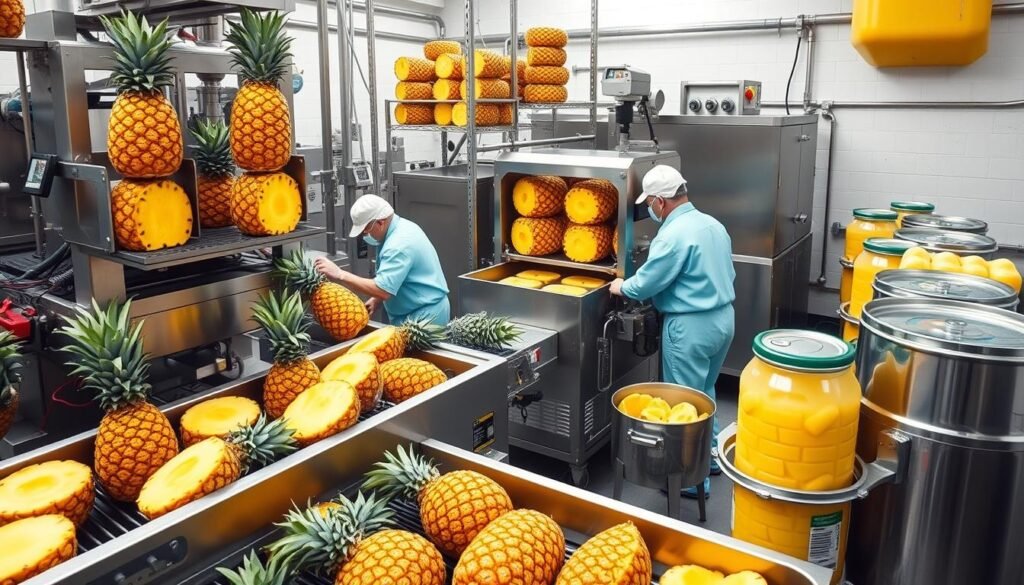
Methods of Pineapple Peeling for Optimal Efficiency
Pineapple peeling is key in making pineapples ready for market. It affects both quality and how fast we can make them. There are different ways to peel pineapples, and choosing the right one can make a big difference.
The old way is manual peeling, which needs skilled people and takes a lot of time. It lets you control the quality but can be slow and uneven. On the other hand, using machines to peel pineapples is becoming more popular. These machines make the process faster and more consistent.
Manual vs Automated Pineapple Peeling
Manual peeling has been around for a long time. It requires skilled workers and a lot of time. While it gives you control over the quality, it can be slow and not always consistent.
Automated peeling, however, uses machines to peel pineapples. These machines are designed to make the process faster and more efficient. They can peel pineapples quickly and consistently, saving time and effort.
The Role of Pineapple Peeling Machines
Pineapple peeling machines have many benefits. They save on labour costs, reduce mistakes, and make peeling faster. These machines work well all the time, giving you consistent results.
As more people want pineapples, especially from March to July, using machines is becoming more important. These machines help keep pineapples sweet and fresh. This makes customers happier.
In short, using machines for peeling pineapples solves many problems with manual methods. It makes the whole process better and more efficient. Machines are a big help in making pineapples for the market.
Modern Pineapple Processing Techniques: Maximising Quality and Yield
We’re always looking for new ways to improve pineapple processing. We use advanced technologies to make better products. This meets consumer needs and keeps quality high. We also focus on making our processes more sustainable.
Advanced Technologies for Deep Processing Products
New methods like freeze-drying and enzyme use are changing pineapple processing. They help make products last longer and stay tasty. Automation also cuts down on waste, making us more efficient.
Energy Efficiency and Sustainability in Processing
Reducing our environmental impact is key. We’re using energy-saving methods to cut down on waste. This helps us meet global goals for sustainability and eco-friendliness.
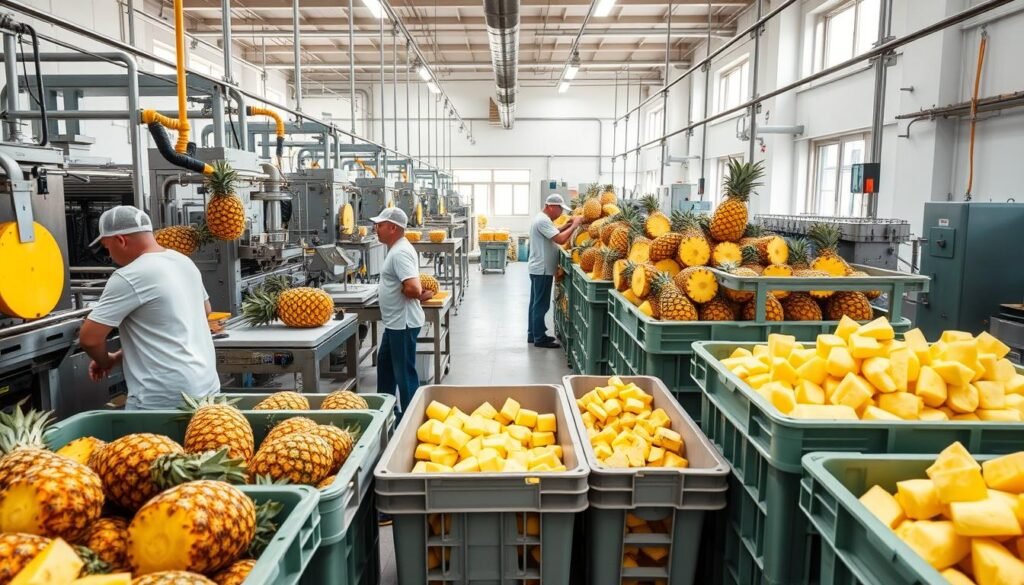
| Processing Methods | Benefits | Environmental Impact |
|---|---|---|
| Freeze-Drying | Extended shelf life, nutrient preservation | Low water usage, reduced spoilage waste |
| Enzyme Utilisation | Enhanced flavour, increased digestibility | Reduction in chemical additives |
| Advanced Automation | Higher processing efficiency, lower labour costs | Less energy consumption, decreased fruit waste |
Automated Pineapple Processing: Transforming the Industry
The pineapple industry has seen a big change with automated processing. This change makes production faster and improves product quality. We look at how new equipment is changing the game, making production lines better and meeting today’s needs.
Benefits of Automation in Pineapple Processing Plants
Automating pineapple processing brings many benefits:
- Increased Production Speed: Automation makes processing quicker, helping businesses meet demand without losing quality.
- Consistency in Product Quality: Machines process everything the same way, reducing mistakes that can lower standards.
- Reduced Operational Costs: Using top-notch machines, like the automatic pineapple peeling machine from Guangzhou Li An Machinery Co., Ltd, saves a lot of money. It can replace over 15 workers, cutting down on labour costs.
- Higher Output Rates: Automated systems can increase flesh output by up to 20% compared to manual methods.
Cutting-Edge Equipment for Enhanced Production
Guangzhou Li An Machinery Co., Ltd, started in 2019, is a big name in food processing machines. With over 60 staff and a 8000 square metre workshop, they focus on innovative pineapple processing gear. Their automatic pineapple peeling machine stands out with:
| Feature | Description |
|---|---|
| Global Reach | Used in over 19 countries, showing it’s widely accepted and works well. |
| Customer Satisfaction | More than 46 happy customers prove its dependability and efficiency. |
| Multi-Industry Versatility | Works in many fields, like dried mango, pineapple tin, and frozen pineapple processing. |
| Certifications and Patents | Has many CE certifications and invention patents, showing it meets standards and is innovative. |
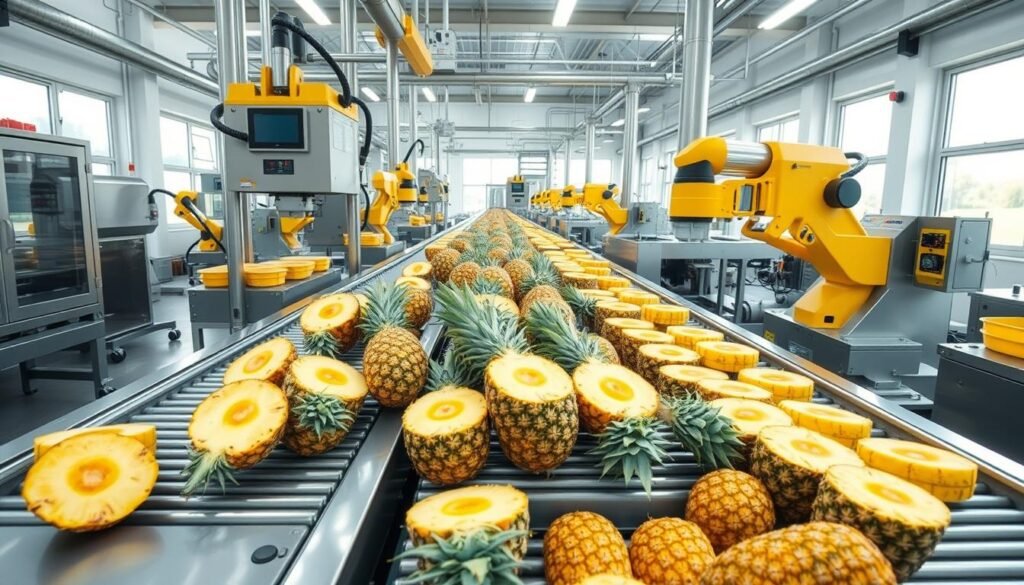
Advances in automated pineapple processing have made operations smoother and products better. As the industry grows, using technology is key for success and growth.
Pineapple Processing Equipment: Essential Tools for Success
Choosing the right equipment is key for top-notch pineapple processing. Different machines help boost efficiency, productivity, and juice yield. Knowing our options and goals helps us make smart choices for success.
Types of Equipment Used in Pineapple Processing
Effective pineapple processing needs specific machinery. Here are some key types:
- Peeling Machines: These use a peeling blade that’s 80 mm long and 45 mm wide. They work best with a 2 mm thickness. The blade is made of spring steel for durability and precision.
- Dicing Machines: These cut pineapples into even pieces. This improves presentation and makes them easier to use in food services.
- Juicing Equipment: This equipment can get up to 95% juice. It’s crucial for getting the most juice from the fruit.
- Storage Solutions: Good storage systems keep product quality high. They help extend shelf life and manage inventory well.
Choosing the Right Equipment for Your Needs
When picking equipment, consider a few key factors:
- Processing Capacity: We can choose from machines that handle 12 tons to 5000 tons daily. This flexibility suits different operation sizes.
- Energy Efficiency: Using energy-saving tech, like large tube-in-tube sterilisation, can cut energy use by 30%. This meets our sustainability goals.
- Customisation: Knowing our exact needs lets us work with manufacturers. Together, we can create custom processing lines for 10T to 1500T daily.
- Motor Specifications: For example, AC and DC motors are used in various machines. AC motors need 64.10 W power and give 3.15 Nm torque at 1440 RPM.
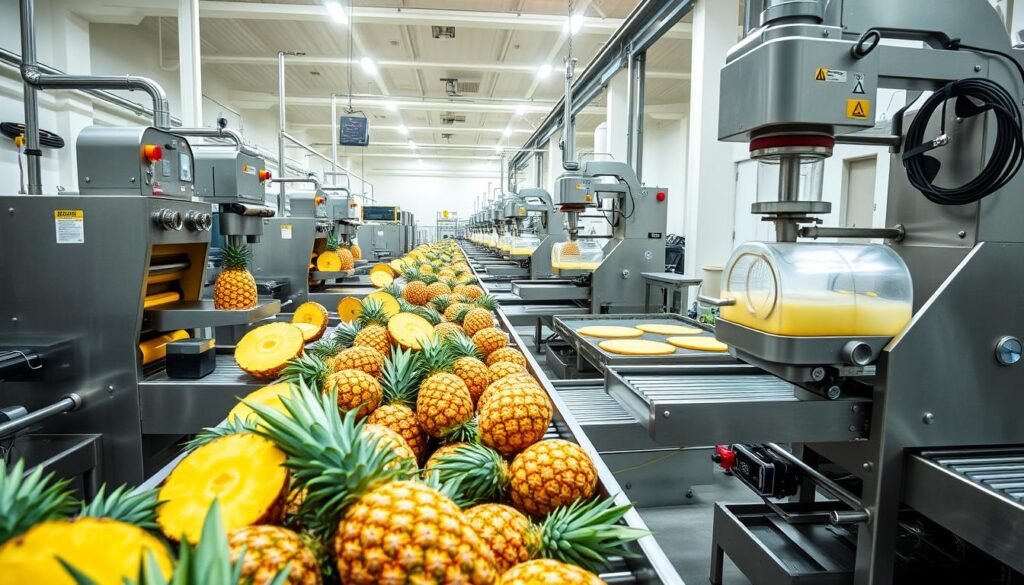
The Economic Impact of the Pineapple Processing Industry
The pineapple processing industry is crucial for the economy of producing countries. It’s important to look at the market value and global trade opportunities. Also, the growth in emerging markets shows its significance and potential.
Market Value and Global Trade Opportunities
The pineapple sector has a big market value, thanks to high yields. In Malaysia, for example, they produce about 335,000 tons of pineapples every year. This leads to a lot of by-products, like pineapple peel, which is about 40% of the output.
This shows the chance for creating more value-added products. As demand for processed pineapples grows, there are many global trade opportunities. Malaysia, for instance, exports around 42,129 metric tons of pineapples, making it a key player in the international market.
The Growth Potential in Emerging Markets
Emerging markets have a lot of growth potential in the pineapple processing industry. New technologies can open up more opportunities for growth. Countries like Thailand and Costa Rica have already made a big impact on the global market for canned and juiced pineapples.
Turning pineapple waste into products like organic acids, vinegar, and biofuels offers more chances. By investing in better infrastructure and improving the processing chain, we can increase economic benefits. This will help drive development in emerging markets.
| Year | Pineapple Production (tonnes) | Pineapple Exports (tonnes) |
|---|---|---|
| 2018 | 28,430,017 | 42,129 |
| 2019 | 28,179,348 | Data not available |
| 2020 Est. | Expected growth based on emerging market trends | Growth in export volume |
Innovative By-Products from Pineapple Processing Waste
Exploring pineapple processing, we find that waste makes up about 80% of the fruit. This includes the crown, peels, leaves, cores, and stems from processing and storage. Repurposing this waste supports sustainable practices and creates new products.
Utilising Waste for Sustainable Practices
Pineapple waste is mostly unused, with 80% ending up in landfills. This causes environmental issues like microbial spoilage and air pollution. By using this waste, we can support a circular economy.
Studies show that mixing pineapple waste with other organic materials can lessen environmental harm. This method reduces harmful substances in the air.
Applications in Food, Feed, and Textile Industries
Pineapple waste can be turned into various products. These include:
- Essential oils and ointments for health
- Herbal drinks full of antioxidants
- Energy bars with pineapple’s nutritional benefits
Using pineapple waste in animal feed also offers benefits. It can lower feed costs and support sustainable farming. The waste’s phytochemicals have antimicrobial and antioxidant properties, making it valuable in food production.
This approach reduces waste and increases nutritional value. It maximises the benefits of pineapple production. As we explore these uses, we aim to be sustainable and contribute to different industries.
| By-Product | Application | Benefit |
|---|---|---|
| Essential Oils | Cosmetics, pharmaceuticals | Antimicrobial properties |
| Herbal Drinks | Health beverages | Rich in antioxidants |
| Energy Bars | Functional foods | Nutritional enhancement |
| Animal Feed | Livestock nutrition | Cost reduction, sustainability |
Transforming pineapple waste into new products supports sustainability. It benefits the environment, industries, and consumers.
Functional Benefits of Pineapple Bromelain: A Hidden Gem
Pineapple bromelain is a remarkable enzyme with many health benefits. It’s important in food processing, pharmaceuticals, and cosmetics. Knowing its potential helps us use it to its fullest.
Health Benefits and Applications in Different Industries
Pineapple bromelain is known for its health benefits. It aids digestion and has anti-inflammatory properties. It’s also great for skincare, making skin look healthy and radiant.
Its use in spas and salons can improve customer satisfaction. In the food industry, it makes meat tender and flavorful. Here are some key benefits:
- Promotes digestion and reduces inflammation
- Improves skin health through gentle exfoliation
- Enhances the texture and flavour of food products, such as marbled beef, when incorporated
- Supports the development of innovative cosmetic formulations
Using pineapple bromelain in treatments can enhance spa experiences. It also benefits the food industry by improving meat quality. This is done without compromising safety.
Challenges in Extraction and Utilisation
Extracting pineapple bromelain is not easy. Manufacturers struggle to get enough while keeping costs down. Some challenges include:
- Consistency in enzyme activity levels across different pineapple batches
- Adapting extraction methods for varied applications
- Maintaining stability during storage and transportation
Understanding these challenges is key to improving extraction methods. This will help us use pineapple bromelain more effectively in different fields.
Challenges and Opportunities in Pineapple Processing
The pineapple processing industry faces many challenges. These include market changes and controlling diseases. Yet, there are also chances for growth through innovation and research.
By using new technologies and sustainable methods, we can change this sector. The future looks bright with the use of biotechnology and digitalisation.
Addressing Industry-Wide Issues
One big problem is getting consistent raw materials. Climate change and diseases like black rot can harm crops. Water-heart fruits also affect quality during heavy rains.
To solve these issues, we need new ideas. This includes growing pineapples all year and using precise fertilisers to make crops stronger.
Future Trends and Innovations on the Horizon
New technologies bring hope to the industry. They help with growing disease-free plants and making pineapples available all year. This meets the growing global demand.
There’s also a push for sustainability and reducing waste. We aim to use 48% of waste effectively. This will make our operations more efficient and sustainable.
Conclusion
We’ve looked at how pineapple processing technologies improve the quality and amount of this tropical fruit. These advancements meet today’s market needs and set the stage for the future. A new manual machine shows how innovation can change our processing methods, achieving a 94.1% peeling efficiency.
The role of pineapple processing is huge, supporting a growing industry that supplies the world with canned pineapple, juices, and more. To tackle future issues like waste, using by-products like dietary fibre is key for sustainability.
Looking forward, investing in top-notch equipment is crucial. Machines like Li An machinery‘s dicing machine and peeler can boost production. By using the latest technologies, we can make processing better for the environment and grow the pineapple industry.
FAQ
What are the key technologies used in pineapple processing?
Key technologies include automated peeling machines and advanced dicing equipment. Modern packaging solutions also play a big role. These technologies boost productivity and keep product quality high.
How does automation impact pineapple processing?
Automation makes production faster and more consistent. It also cuts down on costs. This makes it crucial for modern pineapple processing plants.
What are some common pineapple varieties used in processing?
Common varieties are Queen, Smooth Cayenne, and Red Spanish. Each has its own taste and processing needs. This affects how they’re used in different products.
What are the benefits of using a pineapple peeling machine?
Peeling machines save on labour costs and improve efficiency. They help make products better and increase yield.
How does pineapple processing contribute to the economy?
The industry is worth over billion globally. It creates jobs and supports trade. It’s a big economic player.
What sustainable practices are being adopted in pineapple processing?
Practices include recycling waste and using energy-efficient tech. Raw materials are sourced responsibly. These steps reduce environmental harm and improve resource use.
What are the potential by-products of pineapple processing?
By-products are used in food, animal feed, and textiles. They create new income streams and support sustainability.
What challenges does the pineapple processing industry face?
Challenges include raw material availability and global market competition. The industry must innovate to meet changing consumer needs.
How is bromelain utilised in the pineapple industry?
Bromelain, found in pineapples, is used in food, pharmaceuticals, and supplements. It’s valued for its anti-inflammatory properties.
What future trends should we expect in pineapple processing?
Trends include biotechnology, digitalisation, and more automation. These aim to make the industry more efficient and sustainable.
Source Links
- Pineapple processing line – Equipment for Pineapple Plant – https://www.slideshare.net/slideshow/pineapple-processing-line/49153302
- Application of Pineapple Waste to the Removal of Toxic Contaminants: A Review – https://pmc.ncbi.nlm.nih.gov/articles/PMC9610545/
- Use of agro-industrial residue from the canned pineapple industry for polyhydroxybutyrate production by Cupriavidus necator strain A-04 – Biotechnology for Biofuels and Bioproducts – https://biotechnologyforbiofuels.biomedcentral.com/articles/10.1186/s13068-018-1207-8
- Pineapple – https://en.wikipedia.org/wiki/Pineapple
- From fruit to feast: Exploring pineapple-based food innovations – https://www.biochemjournal.com/archives/2024/vol8issue7/PartK/8-6-37-916.pdf
- Pineapple – The Agropedia – https://theagropedia.com/fruit-science/pineapple/
- Comparison of Different Varieties on Quality Characteristics and Microbial Activity of Fresh-Cut Pineapple during Storage – https://www.mdpi.com/2304-8158/11/18/2788
- Characteristic Aroma Compounds from Different Pineapple Parts – https://pmc.ncbi.nlm.nih.gov/articles/PMC6264279/
- Pineapple processing waste (PPW): bioactive compounds, their extraction, and utilisation: a review – https://pmc.ncbi.nlm.nih.gov/articles/PMC9525513/
- PDF – https://www.nepad.org/file-download/download/public/116585
- Design and Development of a Pineapple Peeling Machine – https://corescholar.libraries.wright.edu/cgi/viewcontent.cgi?article=1604&context=jbm
- PDF – https://www.ajol.info/index.php/jasem/article/view/276866/261224
- How To Cut A Pineapple (+ Peeling Pineapple Hack) – https://www.alphafoodie.com/how-to-cut-a-pineapple/
- Pineapple Prowess: From Record-Breaking Fruit Cutting to Global Agricultural Trends – https://farmonaut.com/blogs/pineapple-prowess-from-record-breaking-fruit-cutting-to-global-agricultural-trends/
- Integrated Scale-Adaptive Adjustment Factor-Enhanced BlendMask Method for Pineapple Processing System – https://www.mdpi.com/2077-0472/14/9/1569
- Research Status and Development Trend of Key Technologies for Pineapple Harvesting Equipment: A Review – https://www.mdpi.com/2077-0472/14/7/975
- PDF – https://ijaem.net/issue_dcp/Design and Fabrication of Pineapple Peeling Machine.pdf
- Exploring pineapple peel hydrolysate as a sustainable carbon source for xylitol production – Scientific Reports – https://www.nature.com/articles/s41598-023-46061-8
- Pineapple (Ananas comosus L. Merr.), Waste Streams, Characterisation and Valorisation An Overview – https://www.scirp.org/journal/paperinformation?paperid=111684
- Recent Updates on the Conversion of Pineapple Waste (Ananas comosus) to Value-Added Products, Future Perspectives and Challenges – https://www.mdpi.com/2073-4395/11/11/2221
- Pineapple waste utilization: Wealth from waste – https://www.thepharmajournal.com/archives/2022/vol11issue6S/PartY/S-11-6-101-345.pdf
- Elevate Your Spa Treatments with Amber Products’ Pineapple Exfoliator – https://purespadirect.com/blogs/pure-spa-direct-blog/elevate-your-spa-treatments-with-amber-products-pineapple-exfoliator-scrub?srsltid=AfmBOop_FqaD6-kItL_-nNIzaaFnhWoW2qQ9o6LyFIMuel0G8wsLaZWp
- fresh pineapple juice: Topics by Science.gov – https://www.science.gov/topicpages/f/fresh pineapple juice.html
- pineapple juice pj: Topics by Science.gov – https://www.science.gov/topicpages/p/pineapple juice pj
- The Situation and Challenges of Pineapple Industry in China – https://www.scirp.org/journal/paperinformation?paperid=92640
- Current practices and challenges of pineapple smallholder growers in managing the pineapple waste in Samarahan, Sarawak Malaysia – https://www.myfoodresearch.com/uploads/8/4/8/5/84855864/_4__fr-kliafp-001_matius.pdf
- International Online Medical Council (IOMC) – https://www.iomcworld.org/open-access/effect-of-emananas-comosusem-pineapple-juice-on-hormonal-and-biochemical-profile-of-male-vertebrates-99668.html

